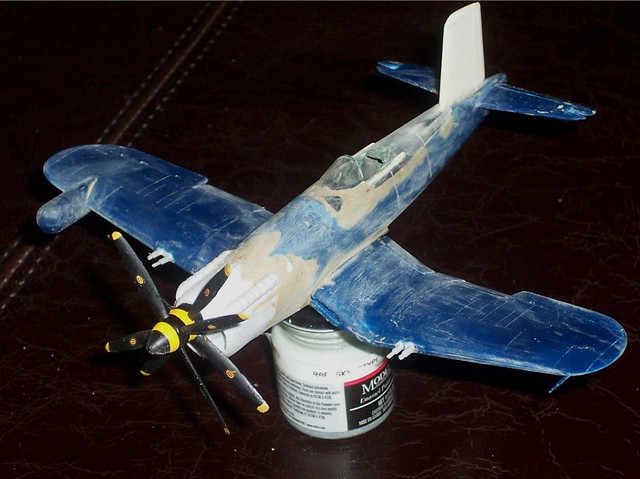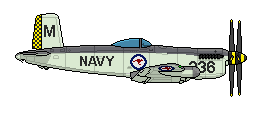Lange nichts mehr von mir gegeben - war beruflich im Brass. Doch ich war nicht untätig, wenn auch nicht im Hardcore-SF-Bereich, sondern (weiterhin) in der Whif-Ecke. Und daher ein Post zu einem m. E. guten Werk, das auch viel positive Resonanz erfahren hat, eine umgebaute Vought F4U Corsair.
Wie so viele meiner Whifs ist es nicht (nur) ein lustig zusammengeschraubtes Fantasie-Flugzeug, sondern es steckt einiges an Recherche im wahren Leben dahinter. Anlass war, dass ich eine Nachkriegs-Corsair bauen wollte, mit britischem Centaurus-Sternmotor. Solche Umbauten gibt es aber rel. häufig, und da kam der Ehrgeiz ins Spiel... Ein weiteres Impuls war ein gerade auf whatifmodelers.com laufender Australien-Group-Build. Eins passte zum anderen, so war die Idee einer australischen Corsair (die es nie gab) geboren.

1:72 Vought-CAC Corsair S(AW).1, '236'/WZ882, Royal Australian Navy, 806 Squadron/HMAS Melbourne, 1957 (Whif/Kit conversion) by
dizzyfugu, on Flickr

1:72 Vought-CAC Corsair S(AW).1, '236'/WZ882, Royal Australian Navy, 806 Squadron/HMAS Melbourne, 1957 (Whif/Kit conversion) by
dizzyfugu, on Flickr

1:72 Vought-CAC Corsair S(AW).1, '236'/WZ882, Royal Australian Navy, 806 Squadron/HMAS Melbourne, 1957 (Whif/Kit conversion) by
dizzyfugu, on Flickr

1:72 Vought-CAC Corsair S(AW).1, '236'/WZ882, Royal Australian Navy, 806 Squadron/HMAS Melbourne, 1957 (Whif/Kit conversion) by
dizzyfugu, on Flickr
Durch Zufall stieß ich dann noch bei der Suche nach einem "anderen" Motor auf ein Umrüst-Set mit Griffon-Motoren von Red Roo aus Australien (eigentlich für Lincoln-Bomber gedacht), und damit hatte ich alles, was es brauchte!
Auf die Resin-Motoren musste ich vier Wochen warten, was aber Zeit gab, am Basisbausatz (eine F4U-7 von Italeri) einiges weiter zu verändern. Die Maschine sollte aus der Nachkriegsproduktion stammen, und erhielt daher einen flachen Rücken mit einer Blasenhaube. Auch das Seitenleitwerk wurde vergrößert, es ist eigentlich ein Höhenruder einer An-12 in 1:100 von Plasticart... Als Propeller kam (natürlich) ein Kontraprop dran - auch er stammt von Plasticart, von einem Tu-20-Bomber in 1:100. Das war's schon - auch wenn vom Rumpf etwa nur noch die Hälfte übrig ist und ich mich wundere, wie das Ding zusammen hält...

 1:72 Vought-CAC Corsair S(AW).1, 1957 (Whif/Kit conversion) - WiP
1:72 Vought-CAC Corsair S(AW).1, 1957 (Whif/Kit conversion) - WiP by
dizzyfugu, on Flickr
Kleine Details wurden noch verändert/ergänzt, wie etwa Landeklappen und Höhenruder jenseits der Neutral-Position (macht viel aus!), andere Kanonen, die britischen 3-Zoll-Raketen statt HVARs samt Start-Schienen sowie und der Radarbehälter (stammt von einem anderen Corsair-Bausatz). Ins Cockpit kam lediglich ein Matchbox-Pilot, sonst ist alles OOB.

1:72 Vought-CAC Corsair S(AW).1, '236'/WZ882, Royal Australian Navy, 806 Squadron/HMAS Melbourne, 1957 (Whif/Kit conversion) by
dizzyfugu, on Flickr

1:72 Vought-CAC Corsair S(AW).1, '236'/WZ882, Royal Australian Navy, 806 Squadron/HMAS Melbourne, 1957 (Whif/Kit conversion) by
dizzyfugu, on Flickr
Beim Anstrich blieb ich klassisch. Ich wollte unbedingt Känguruh-Konkarden draufmachen - diese sind aber erst ab 1957, also nach den Korea-Krieg, eingeführt worden. Die verbaute leider die Chance die Corsair in Extra Dark Sea Grey/Sky Type "S" mit schwarz-weissen "Invasionsstreifen" auszustatten. Dennoch habe ich es beim Anstrich versucht so aussehen zu lassen, als ob diese Bänder rel. frisch überstrichen worden wären. Die schwarz-gelben Markierungen sind fiktiv, ich wollte aber zusätzlich etwas Farbe am Modell und einen Kotrast zum rot-blau der Konkarden haben. Das Modell wurde nur leicht gealtert (Dry-Brushing) und zuletzt alles unter Seidenmatt-Lack versiegelt.

1:72 Vought-CAC Corsair S(AW).1, '236'/WZ882, Royal Australian Navy, 806 Squadron/HMAS Melbourne, 1957 (Whif/Kit conversion) by
dizzyfugu, on Flickr

1:72 Vought-CAC Corsair S(AW).1, '236'/WZ882, Royal Australian Navy, 806 Squadron/HMAS Melbourne, 1957 (Whif/Kit conversion) by
dizzyfugu, on Flickr
Bilder sind, wir üblich, mit der Pocket-Kamera geschossen. Das Modell steht auf einer Rollfeld-Basis, Bilder im Hintergrund sind A3-Poster. Es ist nicjhts montiert, sondern WYSIWYG geknipst. Die SW-Bilder sind mit Effekt bearbeitet (und deshalb SW, weil ich kein passendes Farbmotiv mit der richtigen Perspektive finden konnte...), aber alles ist ziemlich gut geworden.

Das Ding ist subtil und sieht brutal aus - aber nicht unglaubwürdig? Die Aussie-Corsair hat sogar eine Mit-User inspiriert, der Kiste ein Profil zu widmen - welche Ehre!

Profile of Vought-CAC Corsair S(AW).1, '236'/WZ882, Royal Australian Navy, 806 Squadron/HMAS Melbourne, 1957 (Whif) by
dizzyfugu, on Flickr
Und zum Schluss noch die Story dazu:A review by the Australian Government's Defense Committee held after World War II recommended that the post-war forces of the RAN be structured around a Task Force incorporating multiple aircraft carriers. Initial plans were for three carriers, with two active and a third in reserve. A Fleet Air Arm was established on 3 July 1947 by the Commonwealth Defense Council to operate aircraft from these. The first, HMAS Sydney, entered service in 1948.

1:72 Vought-CAC Corsair S(AW).1, '236'/WZ882, Royal Australian Navy, 806 Squadron/HMAS Melbourne, 1957 (Whif/Kit conversion) by dizzyfugu, on Flickr
Sydney was the only non-US, non-UK aircraft carrier to be involved in the Korean War. Sydney's maiden voyage saw the delivery of the first two squadrons operated by the Fleet Air Arm: 805 Squadron with Hawker Sea Furies, and 816 Squadron with Fairey Fireflies. The RAN's second aircraft carrier, HMAS Melbourne, had encountered delays while upgrading to the latest technology, and the British aircraft carrier HMS Vengeance was loaned to the RAN from 1952 until 1955, when Melbourne was commissioned.
At this stage it was clear that the RAN needed some more aerial punch for its new carriers beyond its fast Sea Furies and outdated Fireflies. Hence, search began for a complementary fighter bomber. The Douglas A-1 Skyraider was an initial candidate, but it finally was rejected because it appeared to be too slow and limited to the CAS role. The Westland Wyvern was another candidate, but considered to be too complex and large. Despite the advent of the jet age, a rather simple and robust aircraft with a piston engine was demanded as a ground-attack version for low altitudes. In early 1949, a proven candidate was found: Vought's F4U-5 Corsair, even though in a much modified version.

1:72 Vought-CAC Corsair S(AW).1, '236'/WZ882, Royal Australian Navy, 806 Squadron/HMAS Melbourne, 1957 (Whif/Kit conversion) by dizzyfugu, on Flickr
The Corsair was quickly adopted, since time was pressing. But despite the urgency through the Commonwealth Defense Council, the RAN Corsair would considerably differ from its American counterparts: The RAN decided to replace the original Pratt & Whitney R-2800 radial engine with a Rolls Royce Griffon engine. A major change, but the Griffon offered better fuel efficiency and saved overall weight, despite the prominent water radiator bath under the propeller.
The longer nose section earned the Australian Corsairs the nickname ‘Longneck’, inspired by typical 750ml bottles of beer in South Australia. These aircraft could also be easily identified through a massive, four-bladed contraprop with a long, pointed spinner. Major benefit of the contraprop was a much improved low speed handling through reduced torque effects and enhanced throttle response - a vital feature on the relatively small Australian carriers' flight decks. This new arrangement changed the Corsair's silhouette completely, but also improved aerodynamics, so that, despite a nominal decrease in power, almost all performance features could be kept.

1:72 Vought-CAC Corsair S(AW).1, '236'/WZ882, Royal Australian Navy, 806 Squadron/HMAS Melbourne, 1957 (Whif/Kit conversion) by dizzyfugu, on Flickr
Other obvious external modifications were an enlarged fin with a square shape for better directional stability at low speeds and the introduction of an almost frameless perspex bubble canopy - reminiscent of Goodyear's F2G "Super Corsair" from late WWII and improving both aerodynamics as well as the rearward field of view. Less visible were many British standard equipment pieces, like the Hispano Mk. V cannons, the radio or the electric system. Effectively, almost no part of the Australian Corsairs would be interchangeable with its US cousins!
The aircraft were to be assembled in Australia at the Port Melbourne plant of CAC. Raw airframe kits were imported from the USA via ship, as well as the Australian Corsairs' engines, which came directly from Great Britain. A total of 34 ‘Longnecks’ were built from these imported kits. The new aircraft were ready for service in October 1950 and received the official designation ‘Corsair S.1’, All machines were exclusively allocated to 806 Squadron, which was initially based on HMAS Sydney.

1:72 Vought-CAC Corsair S(AW).1, '236'/WZ882, Royal Australian Navy, 806 Squadron/HMAS Melbourne, 1957 (Whif/Kit conversion) by dizzyfugu, on Flickr
RAN Corsairs quickly saw hot action, when HMAS Sydney was deployed to Korean waters in late 1951, with a wartime CAG of 805, 806, 808, and 817 Squadrons embarked. The CAG conducted its first raids on 5 October 1951 with 32 sorties mounted in the 'Wales' area in the south-west of North Korea. Six days later, Sydney's CAG flew a light fleet carrier record to date of 89 sorties in one day conducting attacking raids and targeting sorties for USS New Jersey. The Fleet Air Arm operated in a strike, ground support, and escort role during the deployment, which saw three RAN pilots killed and a fourth seriously wounded, while a total of fifteen aircraft were lost, including two Corsair S.1.
After just three years of service, starting in 1953 towards the end of the Korea crisis, all RAN Corsairs saw a major equipment update, including an AN/APS-4 radar which was added in a housing under the starboard wing. This simple radar could be used for radar navigation, radar beacon homing and radar bombing, as well as airborne target search, so that the Corsairs could even be employed as night fighters. The modified machines were re-designated SAW.1 ("Strike - All Weather").

1:72 Vought-CAC Corsair S(AW).1, '236'/WZ882, Royal Australian Navy, 806 Squadron/HMAS Melbourne, 1957 (Whif/Kit conversion) by dizzyfugu, on Flickr
All RAN Corsairs served exclusively with 806 Squadron alongside Hawker Sea Furies and later De Havilland See Venom all-weather fighters. After the Korean War the squadron was quickly relocated to HMAS Melbourne when HMAS Sydney was to be decommissioned in the late 50ies. The robust machines were withdrawn from carrier use in 1965 but remained in land-based service at Nowra Air Station until 1968, when the squadron was disbanded and the last machines retired. They were effectively replaced by A-4 Skyhawks.General characteristics:• Crew: 1 pilot
• Length: 37 ft (11.09 m)
• Wingspan: 41 ft 0 in (12.5 m)
• Height: 17 ft 1 1/2 in (5.11 m)
• Empty weight: 9,205 lb (4,174 kg)
• Loaded weight: 14,670 lb (6,653 kg)
Powerplant:• 1 × water-cooled V12 Rolls Royce Griffon RG.25.SM engine with 2.625 hp (1.955 kW)
Performance:• Maximum speed: 426 mph (350 kn, 688 km/h)
• Range: 900 mi (783 nmi, 1,450 km)
• Service ceiling: 41.500ft (12.649 m)
• Rate of climb: 3,870ft/min (19.7 m/s)
Armament:4 × 20 mm (.79 in) Hispano Mk V cannons
4.000 pounds (1.800 kg) of external ordnance, including drop tanks, iron bombs of up to 1.000 lbs. calibre or up to 16× 3" (76.2 mm) rockets